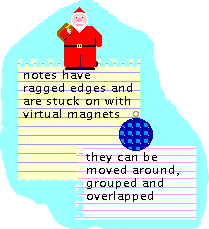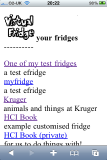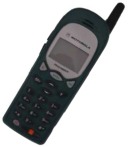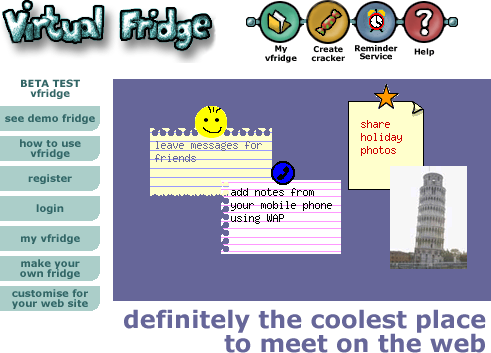I mentioned ‘Project Phoenix’ in my last previous post, and this was it – getting vfridge up and running again.
Ten years ago I was part of a dot.com company aQtive1 with Russell Beale, Andy Wood and others. Just before it folded in the aftermath of the dot.com crash, aQtive spawned a small spin-off vfridge.com. The virtual fridge was a social networking web site before the term existed, and while vfridge the company went the way of most dot.coms, for some time after I kept the vfridge web site running on Fiona’s servers until it gradually ‘decayed’ partly due to Javascript/DOM changes and partly due to Java’s interactions with mysql becoming unstable (note very, very old Java code!). But it is now back online 🙂
 The core idea of vfridge is placing small notes, photos and ‘magnets’ in a shareable web area that can be moved around and arranged like you might with notes held by magnets to a fridge door.
The core idea of vfridge is placing small notes, photos and ‘magnets’ in a shareable web area that can be moved around and arranged like you might with notes held by magnets to a fridge door.
Underlying vfridge was what we called the websharer vision, which looked towards a web of user-generated content. Now this is passé, but at the time was directly counter to accepted wisdom and looking back seem prescient – remember this was written in 1999:
Although everyone isn’t a web developer, it is likely that soon everyone will become an Internet communicator — email, PC-voice-comms, bulletin boards, etc. For some this will be via a PC, for others using a web-phone, set-top box or Internet-enabled games console.
…The web/Internet is not just a medium for publishing, but a potential shared place.
Everyone may be a web sharer — not a publisher of formal public ‘content’, but personal or semi-private sharing of informal ‘bits and pieces’ with family, friends, local community and virtual communities such as fan clubs.
This is not just a future for the cognoscenti, but for anyone who chats in the pub or wants to show granny in Scunthorpe the baby’s first photos.
 Just over a year ago I thought it would be good to write a retrospective about vfridge in the light of the social networking revolution. We did a poster “Designing a virtual fridge” about vfridge years ago at a Computers and Fun workshop, but have never written at length abut its design and development. In particular it would be good to analyse the reasons, technical, social and commercial, why it did not ‘take off’ the time. However, it is hard to do write about it without good screen shots, and could I find any? (Although now I have) So I thought it would be good to revive it and now you can try it out again. I started with a few days effort last year at Christmas and Easter time (leisure activity), but now over the last week have at last used the fact that I have half my time unpaid and so free for my own activities … and it is done 🙂
Just over a year ago I thought it would be good to write a retrospective about vfridge in the light of the social networking revolution. We did a poster “Designing a virtual fridge” about vfridge years ago at a Computers and Fun workshop, but have never written at length abut its design and development. In particular it would be good to analyse the reasons, technical, social and commercial, why it did not ‘take off’ the time. However, it is hard to do write about it without good screen shots, and could I find any? (Although now I have) So I thought it would be good to revive it and now you can try it out again. I started with a few days effort last year at Christmas and Easter time (leisure activity), but now over the last week have at last used the fact that I have half my time unpaid and so free for my own activities … and it is done 🙂
The original vfridge was implemented using Java Servlets, but I have rebuilt it in PHP. While the original development took over a year (starting down in Coornwall while on holiday watching the solar eclipse), this re-build took about 10 days effort, although of course with no design decisions needed. The reason it took so much development back then is one of the things I want to consider when I write the retrospective.
As far as possible the actual behaviour and design is exactly as it was back in 2000 … and yes it does feel clunky, with lots of refreshing (remember no AJAX or web2.0 in those days) and of course loads of frames! In fact there is a little cleverness that allowed some client-end processing pre-AJAX2. Also the new implementation uses the same templates as the original one, although the expansion engine had to be rewritten in PHP. In fact this template engine was one of our most re-used bits of Java code, although now of course many alternatives. Maybe I will return to a discussion of that in another post.


I have even resurrected the old mobile interface. Yes there were WAP phones even in 2000, albeit with tiny green and black screens. I still recall the excitement I felt the first time I entered a note on the phone and saw it appear on a web page 🙂 However, this was one place I had to extensively edit the page templates as nothing seems to process WML anymore, so the WML had to be converted to plain-text-ish HTML, as close as possible to those old phones! Looks rather odd on the iPhone :-/
So, if you were one of those who had an account back in 2000 (Panos Markopoulos used it to share his baby photos 🙂 ), then everything is still there just as you left it!
If not, then you can register now and play.
- The old aQtive website is still viewable at aqtive.org, but don’t try to install onCue, it was developed in the days of Windows NT.[back]
- One trick used the fact that you can get Javascript to pre-load images. When the front-end Javascript code wanted to send information back to the server it preloaded an image URL that was really just to activate a back-end script. The frames used a change-propagation system, so that only those frames that were dependent on particular user actions were refreshed. All of this is preserved in the current system, peek at the Javascript on the pages. Maybe I’ll write about the details of these another time.[back]

I forgot to say, I found out how to do the iPhone screenshot thanks to:
http://www.examiner.com/x-13879-iPhone-Examiner~y2009m6d22-How-to-snap-an-iPhone-screenshot